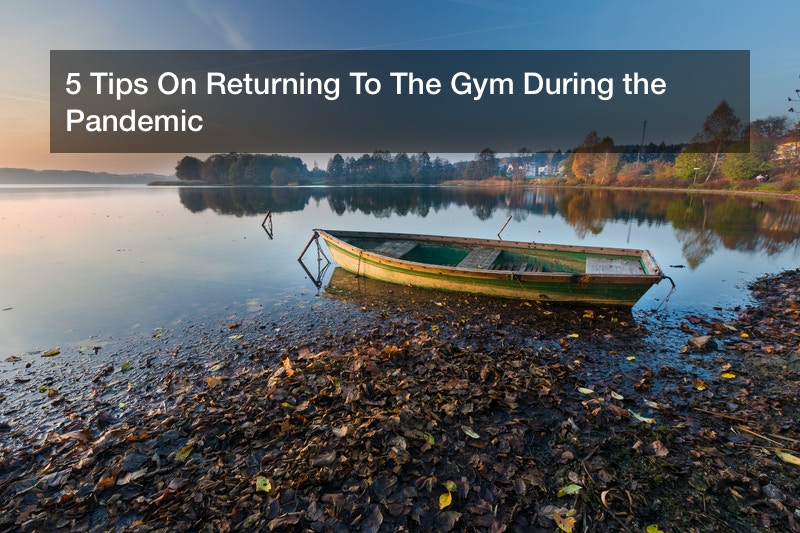
The COVID-19 pandemic changed much for Americans across the country. Much remains unknown about the virus, from how its initial symptoms, to how it is spread. The lack of knowledge of COVID-19 is one reason why there was such a strong response to it within the States. Generally speaking, it is known that the virus can be spread through saliva and mucus, which is why there was a call for the wearing of face masks. Furthermore, the measure of social distancing was strongly implemented, calling for people to stay at least six feet apart from one another. This led to a number of states forcing non-essential businesses to close for weeks at a time, with some just beginning to reopen cautiously. This of course has led to mass furloughs and layoffs. However, it has also forced people to abandon some of their favorite activities, including going to the gym. This of course not only affected people’s ability to be fit and healthy, but to stay mentally well too. The gym is an amazing stress reliever for many, and being disconnected from it can be quite stressful. Therefore, many were excited about the idea of gyms reopening locally.
However, it’s not as simple as going back to the gym and returning to business as usual. Needless to say, even the cleanest gyms offer a risk of exposure to germs, and in turn exposure to the COVID-19 virus. Keep in mind that during the pandemic, it’s not only important to avoid contracting the virus, but also to avoid infection of any kind, as a lowered immune system or preexisting illness can heighten one’s risk of being severely affected by the virus. At the same time, it’s incredibly important for people to get back to their regular workout routines in order to stay healthy. After all, it’s a known fact that regular exercise has been shown to aid in treating cardiovascular issues, while also improving high blood pressure. Fortunately, there are opportunities for people who are not at high risk of catching COVID-19 to enjoy their gyms much like they did before, albeit with some changes to their approach to working out. With that being said, let’s look into the ways that gym-goers can return to their workout activities while limiting their exposure to germs and COVID-19.
1. Ask Questions

Just because gyms have been allowed to reopen in your area doesn’t mean that you must return to your usual gym. While your favorite gym may have been sparkling clean and ideal before the pandemic, standards for cleanliness have changed drastically since then. Technically, gyms should be under the watchful eye of authorities and keeping up with the health standards that they set. However, in some areas, it’s been difficult for the authorities to properly police businesses, and in others those standards may be more lax than your own. Everyone’s expectations of what is healthy during COVID-19 will vary from person to person. But you have the right to feel safe and healthy while at the gym, and you’re at no obligation to remain loyal to a gym that doesn’t handle those issues for you. Therefore, you should feel justified in asking questions and doing your research ahead of time. Don’t feel as if you’re wrong for calling up those managing your gym to ask your questions; whether or not you’ll take them at their word is up to you.
In general, it’s a good idea to have a list of questions that will help you assess your risk of exposure to germs and COVID-19 ahead of time. You may want to ask about how regularly professional cleaning services visit the gym, and for that matter whether or not professional cleaners are utilized at all. Discuss how regularly equipment is cleaned, whether or not the showers are in use in the locker room, and whether or not the gym has standards regarding who can and cannot work out. Some businesses have adopted the practice of taking people’s temperatures prior to admitting them; you may want to ask if your gym has this kind of requirement. Again, gyms will probably be required to follow certain guidelines either way. However, this does not mean that they will in practice. Therefore, if you notice that your gym isn’t following these practices, you may want to rethink going to that gym, and perhaps may want to visit competitors. Unless you live in an extremely rural area, you’ll probably have more than one gym to choose from; and otherwise, you can always work out at home or outdoors!
2. Maintain Social Distancing

Obviously, it may not be entirely possible for everyone to wear masks while working out. Furthermore, some people may be as concerned about their exposure to germs and the virus as you are. But it’s important for you to be responsible for your own social distancing, and to stay far apart from other people working out. This may mean restricting yourself and changing your approach to the gym. For example, you may want to visit your gym’s indoor pool as per usual, and in principle, there isn’t much evidence to indicate that going to the pool itself will expose you to the virus. However, if the pool is full of other gym visitors, the risk becomes much higher. Therefore, you may need to avoid that particular location, and any other that is particularly packed. Theoretically, the gym may be responsible for policing these numbers, but you will need to make the effort to distance yourself.
The same would go for when you’re working out. If your favorite pieces of gym equipment are not properly distanced from one another, you may have to choose something else, or only use that equipment when none of the other machines are being used. In fact, you may want to be even more distanced than you normally would while working out as opposed to simply going about your day. While you normally would distance yourself at least six feet apart from other gym visitors, when working out you may want to expand that distance to 12 feet apart. One reason why this is the case is that when working out, people are huffing and puffing and therefore more likely accidentally expel saliva. Furthermore, some research has indicated that the virus may very well be passed through breathing. For that matter, generally speaking, germs can easily be passed in the same manner. When working out in a more relaxed manner, you may also want to wear your mask. While it might be difficult to breathe easily through your mask while jogging, it’s often much easier to do so if you’re practicing yoga. Indeed, you may benefit from changing the types of exercise that you rely upon.
3. Keep An Eye On Air Flow

While it may be easy for you to assess whether or not your gym is taking care of its window cleaning, and ensuring that its equipment is kept spotless, airflow often doesn’t come to mind when people are inspecting their gyms. But it’s incredibly important, in a post-pandemic world, to ensure that any place in which you’re spending a lot of time has proper ventilation. A number of older gyms may not be well-ventilated, but changes can be made to ensure that they’re healthier. Not only will this ensure that people are less exposed to COVID-19; it will also cut down on their exposure to germs in general.
Why is this? Well, for one thing, more ventilation will ensure that if the virus does stay in the air, that air will be regularly circulated out. While it may seem that this isn’t overly necessary as long as the gym checks up on temperatures, some people are not noticeably symptomatic. Many of those who carry and can transmit COVID-19 are asymptomatic. This means that they can pass on the virus, but don’t show any symptoms themselves. When trying to cut down on their clients’ exposure to germs and the virus, it’s important that gyms take these asymptomatic carriers into mind, as well as the fact that the way through which the virus is transmitted remains ambiguous. This means that they must not only pay attention to air flow, but also the need to clean areas in which germs and allergens might clean. Gyms with rugs and carpets in certain areas should enlist carpet and area rug cleaning services to aid in these efforts, and ensure that any furniture they have in lounge areas is thoroughly and regularly cleaned.
4. Consider Gyms With Healthcare Services

Some gyms cater more to specific healthcare needs than others, and it’s possible that you may want to pivot to those types of gyms, as opposed to more mainstream chain gyms. Needless to say, gyms that offer healthcare services or rehabilitation services will limit their clients’ exposure to germs even more than regular gyms. While certainly, gyms that are connected to hospitals and rehabilitation centers offer healthcare services, these types of services are not limited to these types of high level facilities. A lot of health clubs also offer healthcare services, in part because health clubs are often made with the intent of creating spaces wherein people can not only lose weight but make lifestyle changes that will ultimately result in long-term healthy choices.
Of course, there are also medical fitness centers to consider as well. A medical fitness facility is not the same thing as a typical gym, and they have totally different ideas in mind compared to gyms and indeed health clubs. A medical fitness facility is not focused on your appearance or weight loss; unless of course there is a specific amount of weight that you need to lose in order to be physically healthy, which is not always the case. Having a certain body type does not correlate to your health. In a medical fitness facility, employees are qualified to teach clients strategies that will help them be healthy for the long term, not merely the short term. Medical fitness facilities keep on staff doctors, dietitians, and therapists. While clients do not need to see all of these employees, they are presented as options, offering specific services that people can take advantage of at different points in time. One reason why this type of facility might be more appropriate in a post COVID-19 world is that there are simply higher standards regards sanitation and cleanliness, cutting down on that exposure to germs and doctors on hand to make assessments of people might be ill.
5. If You’re At All Worried About Yourself, Don’t Go

Everyone is feeling mentally stressed about being unable to visit their favorite restaurants and bars. Being able to return to your gym routine may seem incredibly important in the moment. However, now is not a time in which people can really ignore necessary restrictions, and we must police ourselves if we cannot completely trust our public facilities to do it for us.
You should take your own temperature before going the gym, ideally after ensuring that you’ve been in a room temperature area for a while; sitting in hot tubs or taking a hot shower can potentially elevate your temperature temporarily. If you have a cough, even if you think it’s due to allergies or a cold, simply stay home. There’s a reason why quarantining is so important. It’s not just about cutting down our own exposure to germs and viruses. It’s about making sure that we do not expose vulnerable people to our germs.
As important as it is to go to the gym when it’s safe, the gym is not a necessary part of working out. People can work out in their home gyms, and they can also work out in the great outdoors. If you’re truly concerned about your exposure to germs and viruses, you may want to put off going back to the gym until a proper vaccine has been created and dispersed throughout the population.



